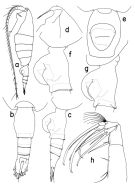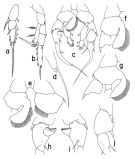|
|
 |
Fiche d'espèce de Copépode |
|
|
Calanoida ( Ordre ) |
|
|
|
Arietelloidea ( Superfamille ) |
|
|
|
Heterorhabdidae ( Famille ) |
|
|
|
Heterorhabdus ( Genre ) |
|
|
| |
Heterorhabdus americanus Park, 2000 (F,M) | |
| | | | | | | Ref.: | | | Park, 2000 (p.127, figs.F,M, Rem.) |  issued from : T. Park in Bull. Scripps Inst. Oceanogr. Univ. California, San Diego, 2000, 31. [p.249, Fig.97]. Female: a, habitus (left side); b, c, urosome (dorsal, left, respectively); d, forehead (left); e, f, genital somite (ventral, left, respectively); g, genital somite from different specimen (left); h, left Mx2 (posterior). Nota: - Cephalosome 46 % length of prosome - Prosome 70 % length of body and approximately 2.2 times length of urosome. - Urosome 31 % length of body. - Length ratios of 4 urosomal somites and left caudal ramus 39.6 : 18.0 : 13.4 : 8.1 : 20.9 = 100. - Mx2: Posterior subterminal spine of 4th lobe 46 % as long as 2nd saberlike spine; falcate spine of 5th lobe with proximal 56 % of medial margin serrated with spinules; falcate spine of 6th lobe with proximal 70 % of medial margin serrated with spinules.
|
 issued from : T. Park in Bull. Scripps Inst. Oceanogr. Univ. California, San Diego, 2000, 31. [p.250, Fig.98]. Female: a, exopod of P1 (anterior); b, P5 (posterior). Male: c, P5 (anterior); d, distal end of exopod of right P5 (lateral); e, basipods of P5 (anterior); f, g, basipod of right P5 (anterior, tilted clockwise, respectively); h, i, second exopodalsegment of right P5 (anterior, posterior, respectively); j, exopod of left P5 (anterior). Nota: - Prosome 72 % length of body and about 2.5 times length of urosome. - Urosome 28 % length of body. - Caudal rami and setation as in female - left geniculate A1 similar in morphology to that of H. spinifrons- All other cephalosomal appendages and P1-P4 as in female
|
 Heterorhabdus americanus Heterorhabdus americanus female: 1 - See key to species groups of Heterorhabdus: ''abyssalis'' Group (p.90, 114). 2 - Genital somite without a conical projection mediodorsally (Fig.97- a, f). 3 - Laterally, genital somite without a tubercular outgrowth posteriorly on dorsal margin (Fig.97-f). 4 - Laterally, genital operculum far short of reaching posterior end of somite (Fig.97-c). 5 - Laterally, right and left genital flanges symmetrical. 6 - Laterally, genital prominence distinctly separate from ventral wall of somite (Fig.97-f). 7 - Dorsally, as well as ventrally, lateral swellings of genital somite reaching posterior end of somite (Fig.97-b). 8 - Laterally, genital prominence far short of extending to posterior end of somite; genital somite with a low dorsal hump. 9 - Laterally, genital operculum reaching posterior end of genital prominence (Fig.97-c).
|
 Heterorhabdus americanus Heterorhabdus americanus male: 1 - See key to species groups of Heterorhabdus: ''abyssalis'' Group (p.90, 114). 2 - Basis of left P5 without a well-developed inner lobe (Fig.98-c, e). 3 - Basal inner lobe of right P5 armed with normal bristles (Fig.98-c, e). 4 - 3rd exopodal segment of right P5 with a short terminal lobe, less than 1/3 length of terminal spine (Fig.98-c, d). 5 - Basal lobe of right P5 arising from anteromedial side of segment (Fig.98-a). 6 - 2nd exopodal segment of left P5 with outer spine not borne on a conical process (Fig.98-c, j). 7 - 3rd exopodal segment of right P5 with terminal spine longer than 1/2 length of segment (Fig.98-c). 8 - Anteriorly and when tilted clockwise, basal lobe of right P5 recurved by folding. 9 - Anteriorly, basal lobe of right P5 slightly folded (Fig.98-e). 10 - Basal lobe of right P5 conspicuously inflated distally (Fig.98-e).
| | | | | Ref. compl.: | | | Park & Ferrari, 2009 (p.143, Table 8, biogeography). | | | | NZ: | 3 | | |
|
Carte de distribution de Heterorhabdus americanus par zones géographiques
|
| | | | Loc: | | | E Pacif. (20° S - 31° N; America westward to 119°W)
Type locality: 16°09'S, 75°42'W.
For Park (2000, p.128) the species is taken in the east Pacific between 20°20' S and 31°38' N and from the west coast of the Americas westward to 118°53' W. This findings seem to indicate that the species is endemic to the coastal area of the eastern tropical Pacific. | | | | N: | 1 | | | | Lg.: | | | (824) F: 3,52-3,12; M: 3,36-2,96; {F: 3,12-3,52; M: 2,96-3,36} | | | | Rem.: | "Abyssalis" Group.
Cette espèce semble endémique à la zone côtière tropicale ouest américaine.
Voir aussi les remarques en anglais | | | Dernière mise à jour : 17/10/2017 | |
|
|
 Toute utilisation de ce site pour une publication sera mentionnée avec la référence suivante : Toute utilisation de ce site pour une publication sera mentionnée avec la référence suivante :
Razouls C., Desreumaux N., Kouwenberg J. et de Bovée F., 2005-2026. - Biodiversité des Copépodes planctoniques marins (morphologie, répartition géographique et données biologiques). Sorbonne Université, CNRS. Disponible sur http://copepodes.obs-banyuls.fr [Accédé le 07 janvier 2026] © copyright 2005-2026 Sorbonne Université, CNRS
|
|
 |
 |





